Taxon Attribute Profiles
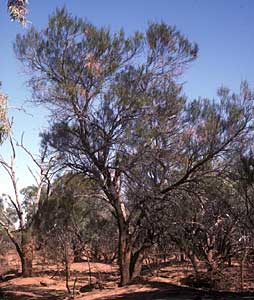
Acacia stenophylla
Currawinya National Park (M.Fagg 1992) |
Acacia stenophylla A.Cunn. ex Benth.
Eumong, River Cooba
Introduction
Acacia stenophylla is a common component of watercourse-fringing
vegetation in inland arid areas of eastern Australia. A small tree with
a somewhat weeping habit it is tolerant of saline, alkaline and waterlogged
soils and survives periodic flooding.
Taxonomy and Ecology
Classification
Family: Mimosaceae
Genus: Acacia – c. 1200 species worldwide, approximately
900 of these endemic to Australia.
Notes: For recent taxonomic descriptions of Acacia stenophylla
see Maslin (2001) and Cowan and Maslin (2001).
Life form
Acacia stenophylla is an erect or spreading shrub or small tree
to 20 m tall with a rounded crown. It varies in form over its distribution
but is usually single stemmed (Boxshall and Jenkyn, 2001) with pendulous
branchlets. Acacia stenophylla generally lives for more than 50
years (Thomson, 1987). See Marcar et al. (1995); Cowan (1996);
Cowan and Maslin (2001); Kodela and Harden (2002) for further descriptive
information.
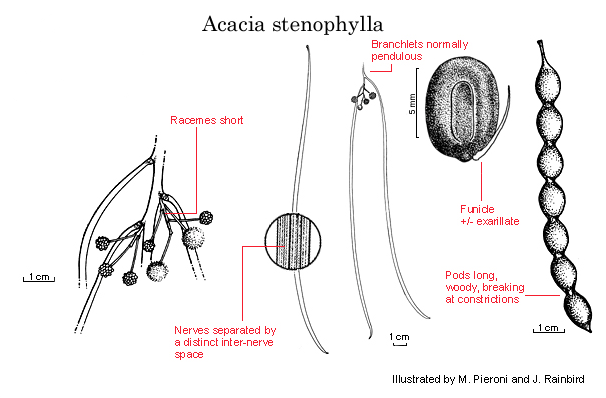 (ex
Maslin, 2001) (ex
Maslin, 2001)
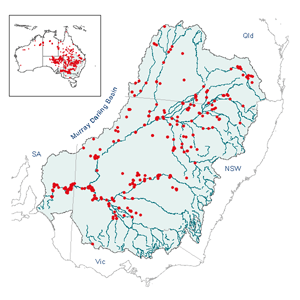
click to enlarge
|
Distribution
Acacia stenophylla is very widely distributed in inland arid areas
from north-eastern Western Australia, east through Northern Territory
to Queensland (west of the Great Divide) and south to the Murray-Lachlan-Darling
River system in New South Wales, Victoria and South Australia, disjunct
in SA between Lake Eyre and Murray River (Cowan and Maslin, 2001). It
grows in ribbon-like stands along watercourses and as a component of eucalypt
woodland or forest close to rivers (CAB International, 2000).
Map showing distribution within Australia as well as in the Murray Darling
Basin.
Habitat
Acacia stenophylla usually grows in heavy soils on plains and
gentle slopes adjoining flood zones, depressions and watercourses (Boxshall
and Jenkyn, 2001), or along watercourses subject to periodic flooding
(Cowan and Maslin, 2001). Soils are mainly fine-textured alluvials, grey
cracking clays and red sandy clays, typically with a neutral to alkaline
pH. Soils may also be saline and subject to extended periods of waterlogging
(Marcar et al., 1995).
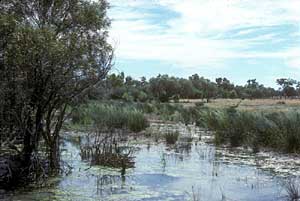
Acacia stenophylla (shrub left) with lignum on edge of Dynevor
Lakes near Thargomindah. (R.Purdie 1984)
|
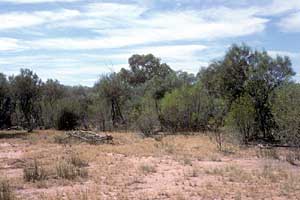
Acacia stenophylla with Myoporum acuminatum near Dynevor
Lakes near Thargomindah. (R.Purdie 1984) |
"Status" in community
Acacia stenophylla is a dominant small tree of watercourses
in the Murray-Darling Basin. Acacia stenophylla woodland occurs
patchily through the western part of the Basin, for example, on the Chowilla
floodplain, the lower Lachlan river valley, the Gwydir floodplain and
on the Paroo system (Roberts and Marston, 2000). It frequently forms monospecific
stands (Cowan and Maslin, 2001).
Associated species
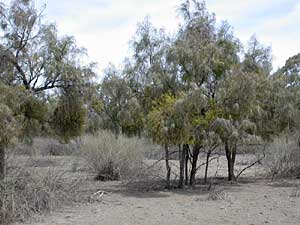
Acacia stenophylla (with mistletoe Lysiana exocarpi)
and Muehlenbeckia florulenta at Purda Billabong, near Wentworth,
NSW.
(Photo: J. Roberts, 2002) |
Acacia stenophylla is usually a component of open-forest, woodland
or low woodland dominated by eucalypts (Marcar, 1995), often occuring
in narrow stands flanked by Eucalyptus camaldulensis (Boxshall
and Jenkyn, 2001). Acacia salicina and A. pendula may also
occur in association (Boxshall and Jenkyn, 2001). Other recorded vegetation
communities for Acacia stenophylla include Astrebla sp.
grasslands and Casuarina cristata, Eucalyptus largiflorens,
E. microtheca and E. populnea communities (Cunningham
et al., 1981). Acacia stenophylla is also recorded in association
with a chenopodiaceous ground layer (Australian National Herbarium, Canberra,
2004).
Acacia stenophylla tall shrubland is one of the main vegetation
communities in the Chowilla floodplain (Sharley and Huggan, 1995).
Qualitative and quantitative data – abundance, cover, biomass
No specific data is readily available relating to cover, abundance or
biomass. As noted above, A. stenophylla can be a dominant small
tree on the edge of watercourses and is often found in monospecific stands.
Species – interactions with other biodiversity
As a legume, Acacia stenophylla has a symbiotic association with
rhizobia enhancing nitrogen fixation (see Dispersability below).
Acacia stenophylla is recorded as a host for the mistletoes Lysiana
exocarpi and Amyema preissii (Whibley and Symon, 1992; Australian
National Herbarium, Canberra, 2004).
Bag shelter moth and webbing caterpillars are minor pests. The seeds
are often subject to attack by borers which drill through the pods (Boxshall
and Jenkyn, 2001). Susceptibility of foliage and stems to insect damage
is considered low (Marcar et al., 1995).
Physiological traits and adaptations
Acacia stenophylla is well adapted to saline and alkaline soils.
It is highly tolerant of waterlogging, enabling it to survive in areas
where flooding occurs, such as beside watercourses and on floodplains
(Marcar et al., 1995).
Reproduction and Establishment
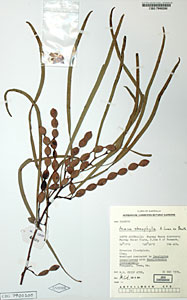
CBG7900200
|
Reproduction
Acacia stenophylla generally flowers from March to August (Kodela
and Harden, 2002). However, it can flower irregularly throughout the year
(Cowan, 1996; Whibley, 1986). Pods become woody as they mature from October
to December, producing approximately 6-12 viable seeds/g (Marcar, 1995).
Number of viable seeds per unit weight of a seedlot has been recorded
as l2-25,000/kg (Harwood, Aspects of Species and Provenace Selection).
Dispersability; establishment and growth
Seeds germinate prolifically (Lithgow, 1997). After major floods seedlings
may be abundant along the flood-line but only a very small proportion
of these persist (Cunningham et al., 1981).
Acacia stenophylla displays moderate to fast growth. It may sucker
on extremely poor sites or if the roots are damaged. It will coppice when
young or in favourable conditions (Boxshall and Jenkyn, 2001).
Acacia stenophylla, like most other native Australian shrubby
legumes, is known to form symbiotic associations with root-nodule forming
bacteria in the genus Bradyrhizobium (pers. comm., P.H. Thrall,
2004). The nitrogen-fixing capabilities of this species, together with
its high level of salt-tolerance makes it an important species for restoration
and revegetation of riverine and floodplain habitats. In particular, the
added nitrogen inputs to the soil provided by A. stenophylla are
beneficial to other non-legume plants in the community. Planting in conjunction
with acacias has been demonstrated to significantly increase growth of
these species as well (Bagnall et al., 2004).
Juvenile period
Acacia stenophylla is a fast growing species and only requires
three to four months under nursery conditions to reach a plantable size
(CAB International, 2000).
Hydrology and salinity
Hydrology
Acacia stenophylla tolerates drought and periodic waterlogging
and flooding (Marcar et al., 1995). It performs well on sites with
shallow water tables (Boxshall and Jenkyn, 2001), however, it is only
moderately drought tolerant in cultivation (CAB International, 2000).
Salinity tolerance
This wattle is adapted to saline, heavy clay soils in arid and semi-arid
areas where supplementary groundwater is available. Expect reduced growth
at ECe ca. 10-15 dS/m and reduced survival at ca. 15-20 dS/m
(Marcar et al., 1995). Acacia stenophylla has displayed
both higher survival rates and grown taller under saline conditions than
non-saline conditions, though this is dependent on provenance (Marcar
et al., 1998). It is also tolerant of alkaline soils (Marcar et
al., 1995).
Flooding regimes
Change in water regimes
Altered flood regimes, irrigation development and agricultural practices
have greatly reduced and fragmented the distribution of A. stenophylla
(Boxshall and Jenkyn, 2001).
Response to disturbance (non-hydrological)
Grazing
Acacia stenophylla is rarely utilised by stock, although reported
to be good sheep fodder (Cunningham et al., 1981). It has good
resistance to debarking by stock (Boxshall and Jenkyn, 2001).
Weeds
Acacia stenophylla is considered a woody weed in parts of north-western
Queensland (CAB International, 2000).
Conservation status
Acacia stenophylla is a widespread tree species across Australia,
and is not considered to be at risk.
Uses (including ethnobotanical)
Pods were roasted in a fire, and the seeds, which are relatively large
and nourishing, were eaten by Aboriginals in northern NSW. The wood is
likely to have been used for clubs and boomerangs (Boxshall and Jenkyn,
2001). Wood of Acacia stenophylla is suitable for firewood, fenceposts
and furniture, and the tree itself is suitable for windbreaks, shelter,
shade, mine-site rehabilitation, soil stabilisation, ornamental purposes,
and food production (edible seeds and pods) (Marcar, 1995). It is grown
in the USA in garden plantings, particularly in southern desert regions
(Arid Zone Trees, 1997-2004). It has the potential to be grown in agroforestry
combinations with pastures. While it has not been widely introduced into
any other countries, growth trials have been conducted in India, Pakistan,
Indonesia, the Philippines and Kenya (CAB International, 2000).
Acacia stenophylla is currently little used as a timber species,
but is considered to have great potential in the craftwood and specialty
timber markets. The Victorian Department of Natural Resources and Environment
(now the Department of Primary Industries) has been encouraging its increased
use as part of the response to salinity on riverine plains and the establishment
of plantations in order to develop an adequate supply of high quality
timber (Boxshall and Jenkyn, 2001).
Summary
Along with Eucalyptus camaldulensis, Acacia stenophylla
is one of the few species from the Murray-Darling Basin for which any
significant amount of data is available. Acacia stenophylla is
a widespread species which is closely linked to present drainage patterns
in the drier parts of inland eastern Australia. It is relatively hardy,
being able to cope with waterlogging and high levels of salinity, and
also displays a number of desirable characteristics from a revegetation/rehabilitation
viewpoint (i.e. high seed production, prolific germination, fast growth,
ability to sucker and nitrogen fixing capabilities). It also shows considerable
promise as a commercial tree for agroforestry, in terms of (specialised)
timber and food production.
Even under the currently unfavourable conditions prevailing in the Murray-Darling
Basin, Acacia stenophylla appears to be able to survive and reproduce
satisfactorily, and it should be considered seriously as a species for
rehabilitation of degraded sites in this area.
References
Arid Zone Trees. (1997-2004) Acacia stenophylla (Shoestring Acacia).
Available at: http://www.aridzonetrees.com/acaciasteno.htm [Accessed:
June 2004].
Australian National Herbarium, Canberra. (2004). Australian National
Herbarium Specimen Information Register. Available at: http://www.anbg.gov.au/cgi-bin/anhsir
[Accessed: June 2004].
Bagnall, D.J., Thrall, P.H., Millsom, D., Jeavons, A.C., Waayers, M.,
Harvey, G.R., Brockwell, J. (2004) Symbiotic bacteria enhance establishment
of acacias in recharge areas in north-central Victoria: Is a similar strategy
applicable to discharge areas and to control soil salinisation? Salinity
Solutions Conference Proceedings.
Boxshall, B. and Jenkyn, T. (2001) Eumong- River Cooba, Acacia
stenophylla, Farm Forestry Species Profile for North Central Victoria,
Department of Primary Industries, Victoria (DPI).
CAB International. (2000) Acacia stenophylla. Forestry Compendium
Global Module. CAB International, Wallingford, UK.
Cowan, R.S. (1996) Acacia Group 2. In Walsh, N.G. and Entwisle,
T.J. (eds) Flora of Victoria Vol. 3: Dicotyledons, Winteraceae to Myrtaceae.
Inkata Press, Melbourne, p. 607.
Cowan, R.S. and Maslin, B.R. (2001) Acacia stenophylla. In Flora
of Australia 11B. ABRS and CSIRO Publishing, Canberra and Melbourne, pp.
102-103.
Cunningham, G.M., Mulham,W.E., Milthorpe, P.E. and Leigh, J.H. (1981)
Plants of Western New South Wales. Soil Conservation Service of New South
Wales.
Harwood, C. Aspects of Species and Provenace Selection. Available at:
http://www.florabank.org.au/support/articles/sowingtheseeds.doc [Accessed:
June 2004].
Kodela, P.G. and Harden, G.J. (2002) Acacia. In G.J. Harden (ed)
Flora of New South Wales. Vol. 2. University of NSW Press, Sydney, p.
434.
Lithgow, G. (1997) 60 Wattles of the Chinchilla and Murilla Shires. M.G.
Lithgow, Chinchilla, Qld.
Maiden, J.H. (1922) The Forest Flora of New South Wales, Volume 7. Available
at: http://setis.library.usyd.edu.au/pubotbin/toccer-new?id=mai.p00108v7.sgml&images=acdp/gifs&data=/usr/ot&tag=botany&part=21&division=div1
[Accessed: June 2004].
Marcar, N., Crawford, D., Leppert, P., Jovnic, T., Floyd, R. and Farrow,
R. (1995) Trees for Saltland: A Guide to Selecting Native Species. CSIRO
Australia.
Marcar, N.E., Benyon, R.G., Crawford, D.F. and Nicholson, A.T. (1998)
Tree Growth and Water Use on a Saline Site near Wellington, New South
Wales. In Marcar, N.E. and Hossain, A.A.K.M. (eds) Managing Saltland into
the 21st Century: Dollars and Sense from Salt: Proceedings
of the 5th National Conference, Tamworth, 9-13th
March.
Maslin, B.R. (coordinator) (2001). WATTLE: Acacias of Australia. CD-ROM,
Version 1.0 (Australian Biological Resources Study, Canberra, and Department
of Conservation and Land Management, Perth).
Roberts, J. and Marston, F. (2000) Water regime of wetland and floodplain
plants in the Murray-Darling Basin. A sourcebook of ecological knowledge.
CSIRO Land and Water, Canberra.
Sharley, T. and Huggan, C. (eds) (1995) Chowilla Resource Management
Plan: Final Report. Murray-Darling Basin Commission.
Thomson, L.A.J. (1987) Australian Acacias for Saline, Alkaline Soils
in the Hot, Dry Subtropics and Tropics. In Turnbull, J.W.(ed) Australian
Acacias in Developing Countries: Proceedings of an International Workshop
held at the Forestry Training Centre, Gympie, Qld., Australia, 4-7 August
1986. Australian Centre for International Agricultural Research, Canberra.
Whibley, D.J.E. (1986) Mimosoideae. In Jessop, J.P. and Toelken, H.R.
(eds) Flora of South Australia, Vol 2 Leguminoseae-Rubiaceae (4th
ed.). South Australian Government Printing Division, Adelaide.
Whibley, D.J.E. and Symon, D.E. (1992) Acacia’s of South Australia
(2nd ed.). The Flora and Fauna of South Australia Handbooks
Committee, Adelaide.
|

